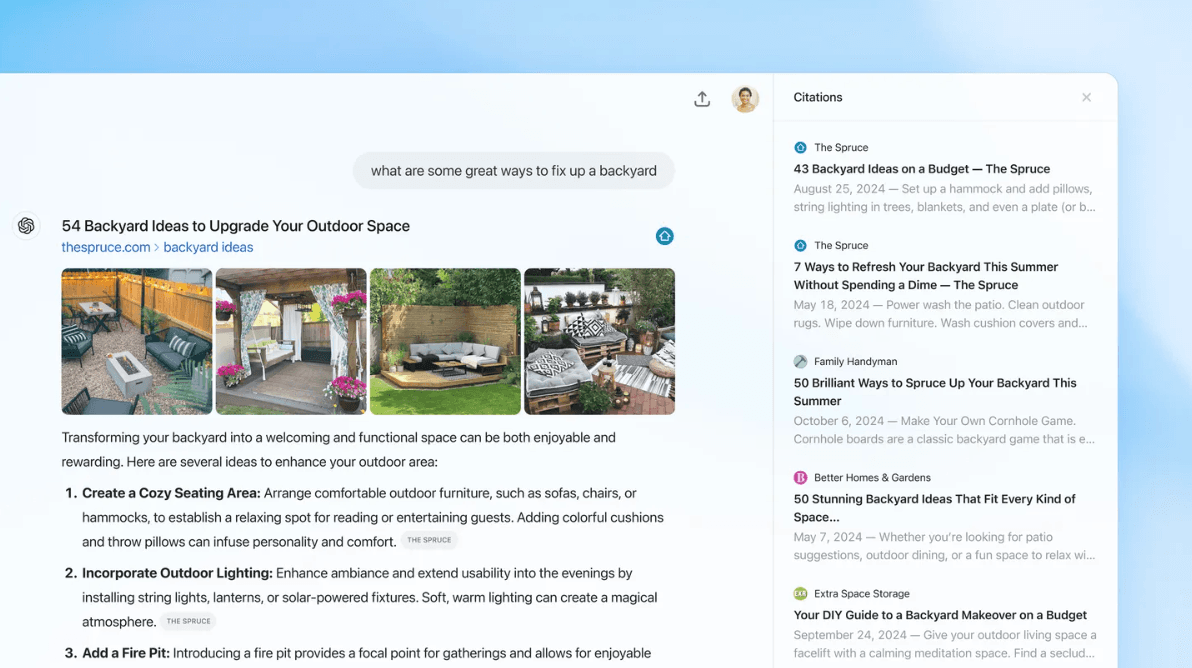SearchGPT & SEO: How Generative AI is Redefining Search Optimization

Vivian
Nov 1, 2024 • 10 min read
Explore how SearchGPT, OpenAI’s latest generative AI tool, is transforming the world of SEO by integrating Bing’s unique search capabilities.

The world of search engine optimization (SEO) is entering a transformative phase. With the launch of OpenAI's SearchGPT—a sophisticated tool that merges the conversational strengths of ChatGPT with real-time search capabilities—marketers and SEOs must prepare for a new paradigm. This shift is fueled by a noteworthy detail: SearchGPT relies on multiple services for its search functionality, with Bing being a primary component. Given Microsoft’s substantial investment in OpenAI, this integration marks a strategic move that could challenge Google’s search dominance and redefine optimization priorities.
For years, SEO has centered around Google's algorithms, shaping how content is created and ranked. However, with Bing playing a crucial role in SearchGPT’s infrastructure, marketers now face the need to optimize their strategies beyond Google. Understanding how Bing's SEO framework differs—and how SearchGPT harnesses these differences—is essential for staying competitive.
In this blog post, we’ll explore what this shift means for SEOs and how marketers can adapt to this new search landscape. We’ll dive into the unique characteristics of Bing’s SEO and share actionable insights to future-proof your strategies.
Key Takeaways
- Bing’s prominence in SearchGPT highlights the need for SEOs to shift focus beyond Google.
- Structured data, rich media, and authoritative sources are critical for Bing’s algorithms and generative models.
- Content strategies should incorporate Bing’s unique characteristics, such as exact keyword matches and strong metadata.
- Localization is essential for global SEO success, emphasizing the importance of culturally adapted content.
Understanding SearchGPT’s Role in SEO
The introduction of SearchGPT by OpenAI represents a major shift in how users will engage with online information. This tool combines the intuitive, conversational nature of ChatGPT with the power of real-time web search. Unlike traditional search engines that rely on users to sift through a list of links, SearchGPT synthesizes responses from a variety of sources and presents cohesive answers directly in its chat interface. This method changes how information is accessed and challenges conventional SEO strategies that focus solely on attracting clicks from search engine results pages (SERPs).
A pivotal insight revealed during OpenAI’s recent AMA is that Bing is one of the main search providers integrated into SearchGPT. As highlighted by Srinivas Narayanan, VP of Engineering, Historically, Bing has commanded only a small share of the global search market. According to StatCounter, as of September 2024, Google dominated with approximately 90% of searches, while Bing accounted for just 4%. This disparity has often led SEOs to prioritize Google’s complex algorithms over Bing’s. However, SearchGPT’s reliance on Bing signals a shift that could elevate its relevance and make optimization for Bing more significant.
SearchGPT's design benefits users by offering quicker and more comprehensive responses, especially for complex queries, as noted by Sam Altman. For SEOs, this means that content needs to be designed not just to rank but to be cited or synthesized effectively by generative engines. To maintain visibility in this new search environment, content creators must adapt to prioritize authoritative, in-depth information that is easy for generative models to parse and summarize.
The implications for SEOs are clear: the landscape is no longer limited to optimizing content for Google’s intricate algorithms. Bing’s presence in SearchGPT means SEOs should pay closer attention to factors that Bing rewards, such as exact keyword matches, strong metadata, and structured data. This shift offers an opportunity to broaden SEO strategies to include practices that may have been secondary considerations before but are now vital for success in the evolving digital space.

How to Optimize SEOs for Bing and SearchGPT
While Bing shares some basic SEO fundamentals with Google, there are notable differences that marketers must understand to maximize their content’s visibility in the SearchGPT-driven future.
Bing’s Preference for Clear Metadata and Schema Markup: One standout feature of Bing’s algorithm is its emphasis on detailed metadata and schema markup. Unlike Google, which leans heavily on AI-driven interpretations of content, Bing relies more directly on explicit signals. Implementing comprehensive schema markup helps Bing better understand the context and structure of your content, making it easier for the search engine—and by extension, SearchGPT—to feature your pages in relevant queries.
Social Signals and User Engagement: Bing is known to factor in social media signals more prominently than Google. This means that content that gains traction through shares, likes, and social engagement can influence how Bing perceives its relevance. Integrating strong social media strategies that promote content sharing can indirectly boost your content’s performance in Bing’s search results, a factor that becomes more relevant with SearchGPT’s use of Bing data.
Visual Content and Multimedia Integration: Bing places considerable importance on rich media, such as images and videos, more so than Google does. Content that effectively integrates high-quality multimedia, optimized with descriptive alt text and relevant metadata, tends to perform better on Bing. This aspect is particularly valuable for businesses producing image-heavy or video-centric content that they hope will be utilized by SearchGPT when compiling answers.
Credibility and Authoritative Sources: Bing’s algorithm puts significant weight on the credibility of a website, which is assessed through trust indicators like domain age and the quality of inbound links. Notably, this focus on credibility aligns with preferences seen in generative engines like ChatGPT. Recent findings, as discussed in our blog post SEOs Are Dead, Long Live GEOs, show that LLMs prioritize content backed by authoritative sources, significantly boosting the likelihood of being referenced in synthesized answers. This further underscores the importance of building content with trusted citations and robust domain authority.
These nuances highlight that while some SEO practices overlap, others need to be tailored specifically for Bing. As SearchGPT incorporates Bing's capabilities, optimizing content with these characteristics in mind will be crucial for achieving higher visibility and relevance in generative search outputs.
Want to optimize your content for Bing and SearchGPT?
Scale your content reach and drive global visibility with Frenglish’s advanced translation and localization services.
Shifting SEO Strategies: Preparing for SearchGPT
Below are actionable steps and examples to help marketers optimize their content for this evolving search landscape.
1. Optimize for Exact Keyword Matches: Bing’s algorithm places significant importance on precise keyword usage, a trait that can influence how SearchGPT surfaces content.
- Actionable Step: Identify high-impact, long-tail keywords relevant to your content and integrate them naturally into titles, subheadings, and the body.
- Example: Instead of optimizing broadly for “best travel destinations,” target specific, high-intent phrases like “top winter travel destinations in Europe.”
- Avoid: Keyword stuffing—maintain readability while integrating keywords in a natural flow.
2. Prioritize Structured Data and Schema Markup: Bing’s reliance on explicit signals means structured data and schema markup are essential for boosting content visibility. While Google uses semantic search to infer context, Bing places more weight on structured formats that clearly define content elements.
- Actionable Step: Implement detailed schema types relevant to your content, such as Article, FAQ, or Product schema, to make it easier for Bing and SearchGPT to understand your content.
- Example: A recipe website could use Recipe schema to structure the ingredients, preparation steps, and cooking time, ensuring Bing indexes this content effectively and that it appears comprehensively in a SearchGPT response.
3. Integrate Rich Media Effectively: Bing values rich media integration, so embedding high-quality images and videos within content can improve engagement and ranking.
- Actionable Step: Ensure all images and videos include descriptive alt text and are optimized for fast loading. Use relevant keywords naturally within these descriptions to reinforce the content’s topic.
- Example: A tutorial blog post on home DIY projects could feature step-by-step images or video instructions with detailed alt text such as “Step-by-step guide to building a wooden planter box.”
- Tip: This visual strategy aligns with SearchGPT’s ability to synthesize multimedia-based content, enhancing how generative models reference your material.
4. Emphasize Credible Sources and Citations: As highlighted earlier, Bing and generative engines like ChatGPT value authoritative content supported by reliable sources.
- Actionable Step: Use citations from authoritative websites, academic journals, or government publications when presenting data or making claims. This adds credibility and aligns with the preference for content that generative models trust.
- Example: A health blog discussing new wellness trends could cite studies from reputable journals to support its claims, making it more likely for SearchGPT to feature this content in its synthesized responses.
5. Enhance User Engagement Signals: Bing factors in user behavior metrics like click-through rates and time on page more than Google does, making content engagement a valuable metric for SEO.
- Actionable Step: Create interactive and engaging content that holds the reader’s attention. Incorporate bullet points, subheadings, and engaging questions to maintain user interest.
- Example: An educational blog post could include quick quizzes or interactive elements that encourage users to spend more time on the page.
- Tip: Sharing content through social media and encouraging user interactions can boost social signals, which Bing considers in its ranking factors.
6. Utilize Local SEO for Targeted Reach: Localization is crucial for marketers aiming to expand into different regions, especially given Bing’s presence in certain global markets.
- Actionable Step: Optimize content with localized keywords and culturally relevant references to appeal to audiences in different regions. Ensure that metadata is translated accurately and reflects regional language preferences.
- Example: A retail brand targeting customers in France should incorporate French keywords and tailor content to local shopping trends, rather than relying solely on direct translations.
By implementing these strategies, marketers can better align their content with Bing’s algorithm and enhance the chances of their material being featured in SearchGPT responses. As the digital landscape evolves, adapting SEO practices to include Bing-specific factors ensures broader visibility and long-term relevance.
In the following section, we will explore the importance of translating and localizing content for global SEO success, especially when considering Bing’s characteristics and generative search practices.
Translation and SEO: A Key to Global Reach
Expanding into international markets requires more than a direct translation of content; it calls for a tailored approach that aligns with regional preferences and search behaviors. Localization in SEO means adapting not just the language, but the context, keywords, and cultural nuances of your content to resonate with audiences in different regions. Without proper localization, even well-crafted content can fail to engage local users or meet the standards of regional search engines, limiting its effectiveness.
Why Localization Matters
Search engines interpret and rank content based on local user behavior, and Bing—integral to SearchGPT—exemplifies this with its specific preferences. Bing’s algorithms often place value on exact keyword matches and structured metadata, making localized SEO crucial for achieving visibility. For example, a keyword that performs well in English may need to be rephrased entirely to match search behavior in French or German.
Moreover, cultural relevance enhances trust and user engagement. Incorporating region-specific references and adapting content to fit local customs helps businesses connect with audiences more authentically.
Maintaining SEO Integrity
Ensuring that SEO best practices are retained during localization is vital. Title tags, meta descriptions, and other key SEO elements should be translated and optimized for each target market to maintain content integrity and search visibility.
Power your translations with AI-enhanced SEO precision.
Frenglish’s AI is continuously updated with the latest localized SEO keywords, so your content translations are optimized for maximum engagement.
Conclusion
The introduction of SearchGPT, powered in part by Bing, marks a significant evolution in the search landscape. As generative AI continues to influence how users access and interact with information, SEOs must rethink traditional strategies and expand their focus to include optimization practices that align with Bing’s preferences. This includes leveraging structured data, emphasizing exact keyword matches, and maintaining rich, credible content that resonates with generative engines.
Localization is another key component in this evolving SEO environment. To capture and engage international audiences, adapting content for local preferences and search behaviors is no longer optional—it’s essential. Proper localization helps ensure that your content remains relevant, trusted, and visible across different regions, which aligns with Bing’s algorithmic focus and maximizes the chances of being featured in SearchGPT’s synthesized results.
As SEOs adapt to this new landscape, the focus should be on creating content that balances high-quality, structured data with cultural and regional relevance. The digital world is changing, and marketers who align their strategies with these shifts will be better positioned to maintain visibility and thrive in an era increasingly driven by AI-powered search.
Unlock Global Growth with AI-Optimized SEO and Translation Services
Ready to scale your business faster? Frenglish empowers you by combining advanced AI-driven translation with SEO expertise tailored for each region. Whether you’re entering new markets, seeking wider visibility, or aiming to drive user engagement, our solutions ensure your content is both relevant and optimized for generative engines like SearchGPT. Partner with us today to maximize your global reach and make a lasting impact.
Continue reading by signing up (it's free!)
Get full access to all our blogs to help you generate revenue
Already have an account?

Vivian
Founder
Vivian is the founder of Frenglish, driven by her passion for technology and product development. Before starting Frenglish, she worked as a product manager and software engineer, specializing in automation and robotics solutions. Throughout her career, she collaborated with prominent clients like Tesla, SpaceX, Google, Amazon, Disney, and others.